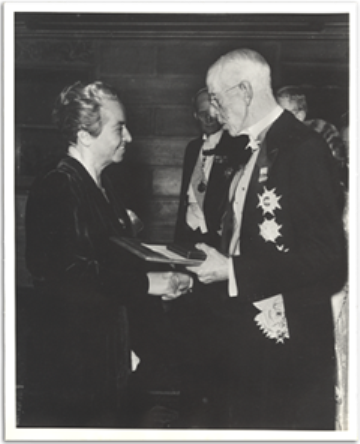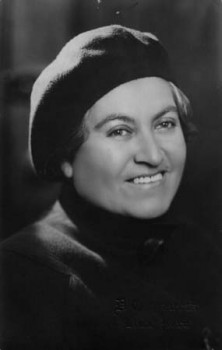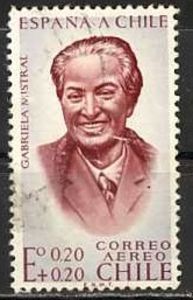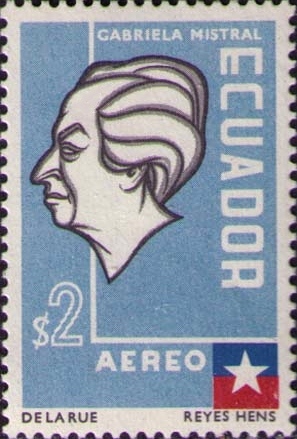Icame to the poetry of Gabriela Mistral through the back door – that is, through her poems for children. As a teacher of graduate students who wanted to write for children, and as someone writing poems for children myself, I was drawn to her cradle songs, her “round dances” and “Tell-a-World” poems, and her “trickeries,” especially the ones that offered up strange images or that went directions that contemporary American rhymes for children do not often go.
DAME LA MANO
A Tasso de Silveira
Dame la mano y danzaremos;
dame la mano y me amarás.
Como una sola flor seremos,
como una flor, y nada más.
El mismo verso cantaremos,
al mismo paso bailarás.
Como una espiga ondularemos,
como una espiga, y nada mas.
Te llamas Rosa y yo Esperanza;
pero tu nombre olvidarás,
porque seremos una danza
en la colina, y nada mas.
GIVE ME YOUR HAND
For Tasso de Silveira
Give me your hand and give me your love,
give me your hand and dance with me.
A single flower, and nothing more,
a single flower is all we’ll be.
Keeping time in the dance together,
singing the tune together with me,
grass in the wind, and nothing more,
grass in the wind is all we’ll be.
I’m called Hope and you’re called Rose;
but losing our names we’ll both go free,
a dance on the hills, and nothing more,
a dance on the hills is all we’ll be.
[unless otherwise noted, translations are all by Ursula LeGuin from her book, Selected Poems of Gabriela Mistral.]
Mistral’s rhythms (especially as translated by LeGuin, who catches both sound and sense perfectly) remind me of the work of Walter de la Mare (“I must go down to the sea again, / to the lonely sea and the sky….”), another writer whose poems for children can inhabit and haunt us.
Most of Mistral’s children’s verses were published in a book titled Ternura (Tenderness); I found a dusty copy among her poetry for adults (and literary criticism about her work) at the graduate library of the University of Washington – my public library didn’t have it. I searched that volume out because I wanted to study how Mistral did it, how she managed to make the leap and bring a certain oddness to her verses for children. While teaching at the Vermont College of Fine Arts, I often asked my students to try to “strange it up” in order to make their work less thin and Seuss-like, more haunting, less Hop-on-Pop. Mistral knew how to do that; it’s a worthy goal for people who think, as Maurice Sendak did, that children can handle more than we give them credit for.
LA RATA
Una rata corrió a un venado
y los venados al jaguar,
y los jaguares a los búfalos,
y los búfalos a la mar…
Pillen, pillen a los que se van!
Pillen a la rata, pillen al venado,
pillen a los búfalos y a la mar!
Miren que la rata de la delantera
se lleva en las patas lana de bordar,
y con la lana bordo mi vestido
y con el vestido me voy a casar.
Suban y pasen la llanada,
corran sin aliento, sigan sin parar,
vuelan por la novia, y por el cortejo,
y por la carroza y el velo nupcial.
THE RAT
A rat ran after a deer,
deer ran after a jaguar,
jaguars chased buffalo,
and the buffalo chased the sea.
Catch the ones who chase and flee!
Catch the rat, catch the deer,
catch the buffalo and the sea!
Look, look at the rat in front,
in its paws is a woolen thread,
with that thread I sew my gown,
in that gown I will be wed.
Climb up and run, breathless run,
ceaseless chase across the plain
after the carriage, the flying veil,
after the bride and the bridal train!
We can almost see the children’s game being played out on the playground there, but the poem has the combination of eeriness and sing-song cadences that Auden’s “As I Walked Out One Evening” and James Fenton’s “Out of the East” have. Mistral’s poems for children are not always sweet and catchy, nor are they hyper-kinetic with wordplay. They might be called quirky and – at their darkest points – unsettling. That’s true, too, of the oddest and most haunting nursery rhymes we have in English (think “Ashes, ashes, we all fall down.”)
EL PAVO REAL
Que sopló el viento y se llevó las nubes
y que en las nubs iba un pavo real,
que el pavo real era para mi mano
y que la mano se me va a secar,
y que la mano le di esta manaña
al rey que vino para desposar.
Ay que el cielo, ay que el viento, y la nube
que se van con el pavo real!
THE PEACOCK
What if the wind blew and bore away the clouds,
and there was a peacock flying in the clouds,
what if the peacock came to my hand
and my hand is going to wither,
and this morning I gave my hand
to the king who came to be married;
O for the sky, O for the wind and the cloud,
all gone with the king’s peacock.
That poem has something of Wallace Stevens in it (“The palm stands on the edge of space. // The wind moves wind in the branches. / The bird’s fire-fangled feathers dangle down”) and something of George MacDonald (author of the classic At the Back of the North Wind.) There are folkloric elements, fantasy elements, and a strong flavor of the fabulous.
When Mistral published Ternura in 1922, she had already been teaching for twenty-two years but was only thirty-six years old. She had been supporting her mother and siblings since she was fourteen, managing to write and publish poetry while she did. A tragic love affair (her lover killed himself over accusations of embezzlement) led to the publication of a book of sonnets (Sonetos de la muerte / Death Sonnets) that won the Chilean National Poetry Prize and established her reputation throughout Chile, all this when she was barely twenty-five years old.
Some critics consider those sonnets her best work, and though they are technically accomplished and passionate, I find her later work more precise, more secular, less sentimental, less florid, and so more connected to the world of senses than to emotional abstractions or questions of religious devotion. After the publication of Ternura, she moved to Mexico, where she tried to help the new Obregon administration establish a post-revolutionary education and library system nationwide. She never again returned to Chile to live, though she represented it as a diplomat in many countries. Neruda studied under her at one point, and both of them, though well-known for their attachment to Chile, spent long years abroad. Though Neruda’s exile was forced, Mistral’s was voluntary. She died in New York in 1957.

As I say, I came to Mistral through the back door. Knocking on the front door, I would have encountered a steelier poet, a more complicated Mistral: Nobel Prize winner, self-styled exile but world citizen, diplomat and activist (the proceeds of the sale of one of her books went to help Basque children orphaned by the Spanish Civil War), renowned educator, and fierce guardian of her personal privacy. “Gabriela Mistral” was not actually the poet’s name – it was used as the pseudonym of Lucila Godoy Alcayaga, born in 1889 in the Elqui Valley of Chile’s Andean Mountains, in the small farming community of Vicuna. Lovely as the more poetic explanation of her pseudonym is (referring to the Archangel Gabriel and to the mistral wind which blows across France toward the Mediterranean Sea), most biographers suggest that the name was chosen to honor the Italian poet Gabriele D’Annunzio and the French poet and philologist, Frederic Mistral, also a Nobel Prize laureate.
Choosing an alternate way to approach her work allowed me to detour around some of her earlier sentimental work and arrive at what I think her strongest poems for adults are, those published later in her life. The series of poems called “locas mujeres” (crazy women), which includes some of my favorites, was published in Lagar (Winepress), Mistral’s last book of poems. By then, she had lost not only her lover but several friends and a well-loved adopted son to suicide. I have an unpublished manuscript of poems for adults titled “The Madwoman”; it’s only natural I would be drawn to those poems of Mistral’s. Looking at a woman’s perspective on the ordinary objects and routines of this world, once she has some kind of emotional and mental dislocation, is intriguing to me, though not quite as personally motivated as it was for Mistral. Randall Couch, author of the book Madwomen: The Locas Mujeres Poems of Gabriela Mistral (he translates the poems – a few of them uncollected at her death – as well as introducing them and addressing the task of translation, both in general and in particular) says that these poems are among Mistral’s most complex and compelling, written “at the height of her powers.” I agree. Couch goes on to say that Mistral “bends the bow of poetry, a frail weapon against the unhinging of consciousness, into strange new forms.”
LA GRANJERA
Para nadie planta la lila
o poda las azaleas
y carga el agua para nadie
en baldes que la espejean.
Vuelta a uno que no da sombra
y sobrepasa su cabeza,
estira un helecho mojado
y a darlo y a hurtárselo juega.
Abre las rejas sin que llamen,
sin que entre nadie, las cierra
y se cansa para el sueño
que la toma, la suelta y la deja.
Desvíen el agua de la vertiente
que la halla gateando ciego,
espolvoreen sal donde siembre,
entierren sus herramientas.
Háganla dormir, póngala a dormir
como al armiño o la civeta.
Cuando duerma bajen su brazo
a avienten el sueño que sueña.
La muerte anda desvariada,
borracha camina la Tierra,
trueca rutas, tuerce dichas,
en la esfera tamborilea.
Viento y Arcángel de su nombre
trajeron hasta su puerta
la muerte de todos sus vivos
sin traer la muerte de ella.
Las fichas vivas de los hombres
en la carrera le tintinean.
Trocaría, perdería
la pobre muerte de la granjera!
THE FARMWIFE
For nobody she plants the lilac,
prunes the azalea,
for nobody carries buckets
of water that reflect her.
Turned towards someone taller
who casts no shadows,
she pulls up a wet fern frond,
plays at giving and taking back.
She opens the shutters though no one calls,
no one comes in, she shuts them,
and wears herself out in the dream
that takes, and frees, and deserts her.
Turn aside the water of the spring
that finds her groping blindly,
scatter salt where she sows,
and bury her farm-tools.
Make her sleep, put her to sleep
like a stoat or a weasel.
when she’s asleep lower her arm
and blow way the dream she dreams.
Crazy Death goes reeling
across the world, drunk,
changes paths, twists fates,
makes earth his dream.
Wind and Archangel of her name
brought to her door
the death of everyone she loved,
and did not bring her own.
Living human poker chips
jingle as he runs.
He must have lost it on a bet,
the poor farm wife’s death.
We all know that a poet, no matter how well his or her books sell in America, will be under-read. The readership for poetry in this country is so small and fiercely segmented, so specific to individual tastes and trends, that we assume a meeting of any poet’s fan club will be sparsely attended (relative to the loyal fan clubs of Stephen King or Barbara Cartland.) This is as true for Billy Collins or Mary Oliver, whose books sell well considering they are full of poems, and whose fans include people who don’t normally read poetry, as it is for a “poet’s poet” like James Merrill or Elizabeth Bishop. Poetry, no matter how well it sells, is not a best-seller in America. So the idea of poet-as-beloved-symbol-of-her-people and “Mother of the Nation” is a bit hard to comprehend.
In 1945, Gabriela Mistral became the first South American to be awarded the Nobel Prize in Literature. She was cited by the prize committee for “her lyric poetry which, inspired by powerful emotions, has made her name a symbol of the idyllic aspirations of the entire Latin American world.” Or, as The Poetry Foundation puts it, “[Mistral] will always be seen as a representative figure in the cultural history of the continent.” Scholarly books of criticism, written by critics who are well aware of the need to be politically correct, still use the slightly objectifying term “la Mistral” when referring to Gabriela Mistral (imagine Pablo Neruda being called “el Neruda”!) and she is often referred to simply as “Gabriela” in the Hispanic communities where her children’s poems are sung as lullabies and read in school, and her reputation as an important educator is sustained. In some segments of Latin American society, Mistral’s reputation paints her with such a saintly or other-worldly brush that she is basically desexualized, not unlike the “mistral” wind her name conjures up, strong but cold. In truth, very little is known about her private life, despite many poems and a large body of personal letters having been poured over for decades by scholars.
What we also know about Mistral is that in South America, at least, she is not undersung; in fact, she’s ubiquitous. Schools are named after her, songs are sung in her honor, festivals and prizes (for poets and teachers) are named after her. Her image was placed on the 5000-peso Chilean bank note (now affectionately called a “gabriela”) in 1981; it has also appeared on stamps throughout South America. When she died and her body was returned to Chile, the Chilean government declared three days of national mourning, and hundreds of thousands of people attended her memorial.
How can a poet born in the Western hemisphere, one who received the Nobel Prize for Literature mid-century, one whose work has been well-translated and reliably kept in print in English, one whose work still reads as modern and relevant, one whose gender might serve as a point of pride for feminists — how can she remain not only undersung among general readers of poetry but among American poets themselves? On the other hand, when I told my sister that I was working on an essay about the Chilean poet Gabriela Mistral and that I was worried, as I had been about a previous essay in the Undersung series about Eugenio Montale, whether Nobel laureates could actually be labelled “undersung,” my sister reminded me that 25% of all Americans believe that the sun revolves around the earth. I guess it’s no surprise Gabriela Mistral is not a household name from Maine to California. Assuming that a large percentage of practicing poets actually know which heavenly objects orbit which, it’s still true that many American poets have never read Mistral’s work – certainly not in its original language.
We’re a lazy bunch here in America, second-language-wise, despite the fact that whole sections of the government now print their official documents in Spanish and English. We’re a bilingual country without a bilingual population – bilingualism is taking its own sweet time to catch on. Hurry up, I feel like saying to my compatriots, learn Spanish and be ahead of the crowd! The benefit of doing so would be not only the ability to converse with and stand together with a growing portion of our fellow countrymen, but the ability to read Octavio Paz, Pablo Neruda, Vincente Aleixandre, Gabriel Garcia Marquez, Juan Ramon Jimenez, Mario Vargas Llosa, Camilo Jose Sela, Jose Saramago, Miguel Angel Asturias (all nine are Nobel Prize winners) and yes, Gabriela Mistral, in the language their work was written in. The current state of affairs seems to suggest that since Robert Frost said (I’m paraphrasing) that poetry is what gets lost in translation, we’ve given ourselves permission not to read translated poetry. After all, if Frost was right, what would be the point? Translated poetry would be an oxymoron. Thank God a few poets – oxymoronic, slippery fish – manage to reach our shores from time to time and make a contemporary splash: Wislawa Szymborska springs to mind, as do C.P. Cafavy and Czeslaw Milosz. But it’s not the feast we might enjoy if we were less Anglocentric. We have an unfortunate history of undervaluing anything — or anyone — that is outside the mainstream, as Langston Hughes understood when he translated this poem by Mistral:
THE PARROT
The green and yellow parrot,
the saffron and green parrot,
called me “ugly,” squawking
with his devilish bill.
I am not ugly, for if I am ugly,
then my mother who looks like the sun is ugly,
the light that is part of my mother is ugly,
and the wind is ugly that sounds in her voice,
and ugly is the water that reflects her body,
and ugly is the world and He who created it…
The green and yellow parrot,
green and shimmering parrot,
calls me “ugly” because he has not eaten,
so I take him bread and wine,
for I am getting tired of looking at him
up there always posed, always shimmering.
—Julie Larios
Julie Larios writes poetry for both children and adults; several of her poems have appeared in the pages of Numero Cinq but she is proudest of her faux-translation “A Cow’s Life,” submitted five years ago to NC’s First Ever Translation Contest. She is the recipient of an Academy of American Poets prize and a Pushcart Prize, and her work has been chosen twice for The Best American Poetry series. Her Undersung series for Numéro Cinq has previously highlighted the work of R.F. Langley, George Starbuck, Robert Francis, Josephine Jacobsen, Adrien Stoutenburg, Marie Ponsot, Eugenio Montale, Alistair Reid, John Malcolm Brinnin, Ernst Jandl and The Poet-Novelist.








